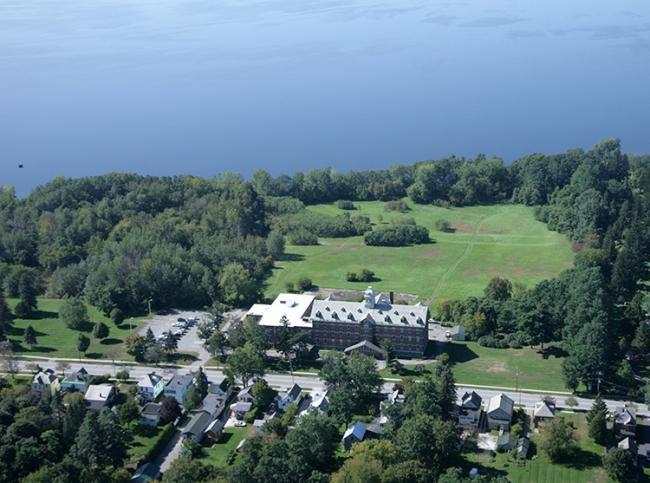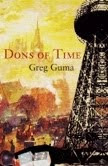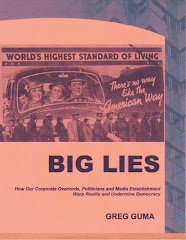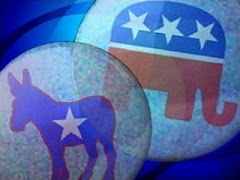If staging coups, waging secret wars, suspending civil liberties, or torturing people were merely aberrations pursued by a handful of zealots, Congress could simply punish the offenders and get back to "business as usual." But the obvious, and yet unspoken, truth is that destabilizing other governments, unnecessary (and sometimes covert) wars, and abuses of power – at home and abroad – are standard tactics of the modern presidency
After first denying such "initiatives," the Reagan and Bush II administrations turned ultimately to a more credible (though not more creditable) response: they had decided that the presidency isn’t bound by the normal rule of law, especially congressionally-imposed limits, when pursuing its "higher" goals. The defense was both the "necessity" of combating evil (aka communism and more recently terrorism) by any means, and the inviolability of presidential authority in most matters of foreign policy and anything defined as a question of "national security."
Yet, the real culprits weren’t Reagan or Bush, although they clearly encouraged a "survival of the fittest" approach to governance. Even in the wake of scandals, no one charged that the president personally ordered torture or collaboration with arms dealers and drug merchants. On the other hand, neither did anyone deny that this has happened regularly in the past. At the root, the problem isn’t a particular group of conspirators but rather an executive structure that supports and condones wanton disregard for the sovereignty of nations and rights of individuals.
The continuing transfer of power to the executive branch is a largely untold story of the last half century, abetted by the cult of commander-in-chief authority, a global network of military outposts, a vast intelligence apparatus, the withholding of information on spurious grounds, and a permanent state of emergency. The process continues in the Obama administration. As John Podesta, Obama's transition chief, explained shortly after the 2008 election, "There's a lot that the president can do using his executive authority without waiting for congressional action, and I think we'll see the president do that.” This time around, conservatives are worried and most liberals cheer him on.
Presidential sovereignty stems from the widely accepted notion that only a single executive can manage US foreign affairs. At the urging of various private interests, this has led to hundreds of US interventions around the world, often with Congress partially, wholly or willingly kept in the dark. The pattern, which began with President James Polk's 1846 calculated provocation of war with Mexico, ultimately went public in the 1980s with the exposure of a worldwide crusade to arm, train and direct various Contra forces. It wasn't "approved" public policy, yet it nevertheless served as the centerpiece of presidential foreign policy during the Reagan years.
Such activities are difficult to manage and control, however, since they require the mobilization of elite, often underground networks and a conscious effort to mislead other parts of the government (not to mention allies and the general public). In the case of the Contra wars, the connection between arms shipments, drug smuggling and assassinations was an organic development, but one the administration could not fully "manage."
Once the "enterprise" was outted, the old alliances no longer held firm but the "initiatives" couldn’t be aborted by presidential decree. And, in truth, there was really no sincere attempt to change course. The Reagan, Bush and Clinton administrations continued to promise military aid or backing in exchange for concessions, promote coups in countries whose policies threatened US interests, arm mercenaries in Latin America, Africa and Asia, manipulate elections in "fragile democracies,” distribute disinformation, and harass the opponents of US policies.
In Costa Rica, journalists Tony Avrigan and Martha Honey uncovered the private network behind much of the Reagan-era mayhem long before the Tower Commission and Iran-Contra Committee launched their investigations. Working with the Christic Institute, they eventually filed a lawsuit charging 29 US citizens with conspiracy. The specific instance spurring the suit was the 1984 bombing of a press conference held by Contra leader Eden Pastora. The "Secret Team" making that attempted assassination possible, and ultimately causing the deaths of eight people, had roots that stretched back over 25 years. Featuring Contragate figures such as Richard Secord, Thomas Clines, Theodore Shackley and an assortment of Cuban exiles and ex-military men, the “team" had handled numerous sensitive, often illegal operations at the behest of the US government. In fact, it had been an instrument of US policy from the early days of Castro (when some members helped plot the leader's death), in Laos and Vietnam, in the overthrow of Salvadore Allende in Chile, in propping up the Shah of Iran, and throughout Central America.
Various researchers and investigations ultimately established the following executive branch participation in the “alleged” Contra conspiracy: Vice President George Bush and his national security advisers had close ties with a secret air-re-supply operation in El Salvador. The State Department, in particular Elliott Abrams, was involved in coordinating Contra activities, bringing together State, the National Security Council, and the CIA. But this was only part of a massive inter-agency program masterminded by CIA Director William Casey. The Defense Department planned airdrops over Nicaragua and provided troops to build the Contra infrastructure. A private aid network, including John Singlaub's World Anti-Communist League, various non-profit fronts, mercenary groups and CAUSA, the political wing of the Moonies, provided cover for an operation that led back to the Oval office.
The Secret Team, eventually headed by Richard Secord, used money from Iran arms sales and other sources to acquire weapons and channel them to Central America, South Africa, and Angola. The Team and the aid network worked with both the Ilopango Airlift in El Salvador and the South Front, coordinated from John Hull's Costa Rican ranch. Drugs and guns moved back and forth. One beneficiary of these efforts was the Nicaraguan Democratic Force led by Adolfo Calero and former Somocistas. Over 80 people, in and out of government, actively worked in this network, with additional financial support from Saudi Arabia and Brunei. The President was aware of and approved most phases of this covert foreign policy.
Still, this was only one episode in a much longer and more convoluted tale. An earlier "Contra" war had been mounted against Cuba under the direction of Richard Nixon, then vice president, beginning in the late 50s. With the cooperation of Mafia don Santo Trafficante, a private "sub-operation" had been developed to assassinate Cuban leaders. Members of the "shooter team" included Rafael "Chi Chi" Quintero, who later coordinated arms shipments to the Contras with Secord; Felix Rodriguez, a CIA operative who headed the Ilopango operation during the 80s and met several times with Bush; and several of the future Watergate burglars. The Cuban operation was supervised by Secord associates Shackley and Clines.
The Team's activities stretched around the world. In Australia, they used opium money and weapons profits to help destabilize the Labour government in 1975. In Nicaragua, they assisted Somoza after Carter and Congress had banned further aid; after the dictator's fall, they armed and advised ex-National Guardsmen until the CIA assumed control of the Contra war. When Congress cut off aid in 1984, Oliver North, who had worked under Singlaub in Laos, reached out to the Team to illegally recommence funding and re-supply the Contras. During the 1980s operations in Central America, they established major supply bases in Honduras, El Salvador, Guatemala and Costa Rica. In the meantime, CIA Director Casey developed other Contra operations in Africa. In return for South African assistance in ferrying arms to Central America, for example, he arranged with Saudi Arabian King Fahd to provide aid to the South African-backed UNITA rebels fighting the Angolan government.
After the White House connections to the Secret Team were exposed, three material witnesses died mysteriously. Others were threatened, and groups involved in bringing the administration and its partners to justice were burglarized and harassed. Christic Institute attorney Dan Sheehan charged that ultra-right elements threatened key witnesses and that, in its embassies in Central America, the US had "a series of fascist and hitlerite cells" controlled by the CIA.
Not all of this emanated directly from the President's office, National Security Council, or even the Company. But the presidential system makes such policies commonplace and, unless exposed in an unfavorable way, acceptable US "policy initiatives." Reagan's assertion that the Boland Amendment didn't apply to him or his staff was merely another attempt to assert unilateral executive power, which in turn could be delegated to associates in and out of government. By extension, attempts to "protect the initiative" became part of the authority flowing from the sovereign. The Bush administration clearly took a page from this text in designing its defense of torture and other abuses.
When Barack Obama became president, many of his supporters assumed that he would reverse the unilateral and authoritarian policies of his predecessor. Yet his CIA chief Leon Panetta soon made it clear that extraordinary rendition wouldn’t end, his Attorney General used “state secrets” as the rationale to block a trial, and Obama personally refused to release photos of enhanced interrogation. He also said that detainees could still be tried in “military tribunals” and that past official crimes would not be prosecuted. It was audacious, but not an auspicious beginning.
The Bush regime left Obama with broad latitude for executive intervention, both domestically and in countries with which the US isn’t at war. Using that power, Team Obama’s new overseas strategy became rollback, which, according to researcher James Petras, means reversing any gains made by opposition governments and movements during the Bush years. Rollback, explains Petras, involves a combination of open military intervention, seductive diplomatic rhetoric, and deniable covert operations. The most transparent manifestation was the buildup of military forces in Afghanistan, defined by Obama as a “necessary” war. The most covert, on the other hand, could be the ouster of Honduran President Zelaya.
There was no admission of US involvement in the Honduran coup. But US policy clearly shifted after Zelaya decided to improve relations with Venezuela in hopes of securing petro-subsidies and aid. Then he joined ALBA, a regional organization sponsored by Venezuelan President Chavez to promote trade and investment among its member countries, rather than a US-promoted regional free trade pact.
The Honduran military, whose officer corps has been US-trained and cultivated over several decades, seized Zelaya and “exiled” him to Costa Rica; the local oligarchy meanwhile appointed one of their own as interim President. Latin American governments condemned the coup and called for Zelaya’s reinstatement. But Obama and Secretary of State Clinton opted to condemn only unspecified “violence” and called for “negotiations” between the coup-plotters and exiled President.
Even after the UN General Assembly demanded Zelaya’s reinstatement, Obama refused to call it a coup. After all, that classification would have led to a suspension of $80 million in annual US military and economic aid. Every country in the OAS – except the US – withdrew its Ambassador. Instead, the US embassy began to negotiate with the Junta. Whether Zelaya returned to office or not, the coup served as a lesson to any other country that considered joining Venezuelan-led economic programs. The blunt message, Petras concludes, is that any such moves would result in presidentially-approved sabotage and retaliation. Don’t expect hearings, or public oversight of any kind.
Two centuries after the US constitutional system was created, it has unraveled under the explosive force of the imperial presidency. The framers, though they could not predict the global dominance of the US, were certainly aware of the dangers of a drift toward monarchy. Unfortunately, their handiwork no longer meets the test. Even though the president needs congressional approval for expenditures and declarations of war, almost anything is permissible if the appropriate "national security" rationale can be manufactured.
Impeachment won’t counter the long-term drift toward executive sovereignty, since a president can only be impeached for "high crimes and misdemeanors" while most of the covert or “illegal” actions condoned or promoted by presidents are tried-and-true policies that Congress dare not condemn, criminal as they may be. According to historian Barbara Tuchman, the office itself "has become too complex and its reach too extended to be trusted to the fallible judgment of one individual." Thus, she and others have suggested restructuring ideas; for example, a directorate or a Council of State to which the executive would be accountable. Ironically, such ideas were discussed and rejected at the Constitutional Convention.
Basic changes are obviously needed. Presidents will continue to seek expanded power until clear limits are imposed and public pressure reverses the trend. In the end, the US may need another Constitutional Convention. As during the original, a stated, narrow purpose may be eclipsed by some “revolutionary” move to revamp the entire document. There is clearly a risk that something worse might be imposed, along with draconian restrictions on basic rights and freedoms. But more positive outcomes are also possible, and, given the way things are going, the risk may turn out to be preferable to the inexorable drift toward presidential tyranny.
Friday, September 23, 2016
Thursday, September 15, 2016
Surrendering Freedom
Casualties of 9/11: Part Four
By Greg Guma
As the US entered World War I in 1917, Hiram Johnson, a US senator from California, issued a warning that went to the heart of the country’s predicament. "The first casualty when war comes is truth," he explained. Although he didn't mention it, the second casualty is just as obvious: freedom. After 9/11, both were offered up eagerly as the national media stoked primal fears, setting the stage for the most dangerous rollback in basic rights since the 1950s.
Consider what followed in the first few months of this "new kind of war": massive secret detentions, curbs on privacy and dissent, media outlets self-censoring their coverage. More than 1100 people were held without criminal charges, often on the basis of weak evidence. Under the hastily-passed USA Patriot Act, investigators were empowered to monitor talks between detainees -- whose names and alleged crimes were classified -- and their lawyers. Wire-tapping, e-mail surveillance, and secret searches all became easier. Solitary confinement and restrictions on visitors could now be imposed for a year, rather than the previous 120 days.
In Arkansas, an Uzbekistani woman was jailed for 40 days for being in a car with someone whose name was similar to someone on the FBI watch list. A young Egyptian who supposedly had a radio transmitter in his hotel room across from the World Trade Center was held for weeks. He turned out to be innocent, but before his release, he was "persuaded" to confess. Had he been tortured? It was a non-issue, news-wise. Meanwhile, the FBI publicly considered using a "truth serum" to crack recalcitrant suspects, and threatened to deport detained foreigners to countries that used torture.
Tom Ridge, the new Homeland Security Director, talked tough, calling all this "a permanent condition to which Americans must adjust." Equally disquieting, many of the ideas came from ultraconservative groups like the Federalist Society, which seized the chance to turn old wish lists into policy. Basically, the limits placed on the FBI and CIA 25 years earlier were being reversed. Beyond that, the wall between the two agencies was being broken down. Henceforth, the CIA would have an official role in deciding who was targeted inside the US and what information was collected. Other law enforcement agencies were obliged to give the Agency access to their information. Basically, the Bureau and the Agency could now work together on operations, including some against domestic political groups and individuals.
What groups? Officially, they were supposed to have connections to terrorists of foreign intelligence agencies. But Attorney General John Ashcroft clarified that. In December 2001, he explained: "To those who scare peace-loving people with phantoms of lost liberty my message is this: Your tactics only aid terrorists. They give ammunition to America's enemies." It was clearly a warning: this new security regime could easily be turned against almost any critic of the government.
Despite the signs, debate over how much freedom to sacrifice was little more than a sidebar to the war in Afghanistan, one small part of round the clock disaster coverage. TV shows telegraphed the main message: The War Room, America at War, Region in Conflict. Polls meanwhile reinforced the argument that most people accepted the situation, and trusted government to handle things. There was also the usual excuse: we'd better be safe -- that is, just accept the creeping implementation of police state tactics -- than sorry.
Many of these developments were mentioned by the press corps. But at the same time, they were explained away as part of a minimal and absolutely necessary response to the new terrorist threat. More to the point, major news outlets openly debated whether the public was being told too much.
Taking the cue, CNN Chair Walter Isaacson ordered his staff to "balance images of civilian devastation in Afghan cities with reminders that the Taliban harbors murderous terrorists," saying it "seems perverse to focus too much on the casualties or hardship in Afghanistan." In a memo, he admonished reporters covering civilian deaths not to "forget it is that country's leaders who are responsible for the situation Afghanistan is now in," suggesting that journalists lay responsibility at the Taliban's door, not the US military's.
As Fairness and Accuracy in Media put it, if anything was perverse, "it's that one of the world's most powerful news outlets has instructed its journalists not to report Afghan civilian casualties without attempting to justify those deaths." CNN had essentially mandated that pro-US propaganda be included in the news, while rationalizing its decision to ignore excesses. The story was the same at Fox News, where news anchor Brit Hume wondered why journalists bothered covering civilian deaths. "The question I have," he said, "is civilian casualties are historically, by definition, a part of war, really. Should they be as big news as they've been?"
NPR's Mara Liasson and US News & World Report's Michael Barone went further, arguing that civilian deaths weren't news at all. What was? Apparently, rampant speculation on every imaginable catastrophe, keeping viewers in a permanent state of anxiety -- and hopefully, glued to the tube for the next live disaster.
An epidemic of self-censorship and convenient reality distortion spread across the country. In Panama City, Florida, a News Herald memo warned editors: "DO NOT USE photos on Page 1A showing civilian casualties from the US war on Afghanistan. Our sister paper in Fort Walton Beach has done so and received hundreds and hundreds of threatening e-mails and the like. DO NOT USE wire stories which lead with civilian casualties from the US war on Afghanistan. They should be mentioned further down in the story. If the story needs rewriting to play down the civilian casualties, DO IT. The only exception is if the US hits an orphanage, school or similar facility and kills scores or hundreds of children."
The fact that truth had taken a back seat was not even disguised. As Hume told the New York Times, "Look, neutrality as a general principle is an appropriate concept for journalists who are covering institutions of some comparable quality." But, he added, "This is a conflict between the United States and murdering barbarians."
Hollywood also jumped on the bandwagon. Stars and heads of production companies conferred with government officials on how best to spread the official line. At the Institute for Creative Studies at the University of Southern California, Hollywood talent consulted with military brass to speculate about future attack scenarios.
At the same time, "inappropriate" comments brought a reprimand or worse. When Bill Maher, then host of TV's Politically Incorrect, said the World Trade Center terrorists might be more brave than the US military, several affiliates dropped the show and ABC boss Michael Eisner threatened to fire him. Eight months later, his show was abruptly canceled. As Bush spokesman Ari Fleischer warned, in times like these, "people have to watch what they say and watch what they do."
A new McCarthyism – call it fascism-lite – was on the rise. Following several incidents in which academics were reprimanded for expressing allegedly unpatriotic views, the American Association of University Professors pleaded for an end to an atmosphere where thinking out loud was considered subversive. But who was even listening? Well, clearly the government, which invoked the "national emergency" to violate even one of the most basic legal rights – attorney-client confidentiality. "If we can't speak with a client confidentially," warned Irwin Schwartz, president of the National Association of Criminal Defense Lawyers, "we might not speak with him at all."
The new anti-terrorism law gave the government sweeping new powers to conduct searches and tap phones with only a suspicion of crime, rather than the old standard, probable cause. Government agents could now seize medical and student records, or track credit-card purchases and large cash transactions. Military tribunals could be used to try and sentence suspects without a jury or public access to the process. Any US attorney could get the FBI to launch its Carnivore Internet surveillance system to monitor a suspect's Internet surfing. "It's a very serious shift in policy and in American culture," noted Ken Gude, an analyst with the Center for National Security Studies. "We're getting to the point where it's guilt by association."
"If we give up our freedom, the terrorists have already won." That became the cliché of the moment. But the reality was much more unsettling: People were surrendering much of their freedom without seriously taking note -- and, as usual, the early winners were the US national security elite and their media enablers.
This is the conclusion of an essay adapted from Greg Guma’s 2003 book, Uneasy Empire: Repression, Globalization and What We Can Do.
Labels:
Democracy,
History,
Perception Management,
War and Peace
Tuesday, September 13, 2016
Nexus of Infamy
Casualties of 9/11: Part Two
By Greg Guma
*****
On September 10, 2001, it looked like there was more than enough time to prepare for whatever came next. The next day, of course, many things changed. Like a volcanic eruption, predictable and yet inevitable, murderous assaults on symbols of US military and economic power shattered the landscape, rocked institutions, and altered how we would live for years to come. Some compared the September 11 attacks to Pearl Harbor, a day that would "live in infamy." Others pointed to the date itself -- 9/11 -- and called it an emergency wake-up call.
In less than an hour, on a sunny Tuesday, two commercial airline flights were hijacked, diverted, and crashed into the World Trade Center in the heart of New York's financial district. A third slammed into the Pentagon, and a fourth crashed before reaching its target, most likely the White House. Hundreds died immediately, and thousands more were killed in the fires and destruction that followed. As TV networks beamed images around the world, political leaders expressed outrage, pledging to track down the perpetrators and "bring them to justice."
That night, the world mourned, and million prayed for salvation from the cycle of violence. No one took "credit" for the carnage, but the initial evidence pointed to the Middle East, Afghanistan, and Osama bin Laden. The urge to go after so-called "rogue states" and their accomplices around the world was irresistible. The Bush administration expressed outrage and shock, claiming the attack could not have been predicted.
Though not much noticed at the time, this was not the first September 11 that had left its mark on world history. In fact, the date marks crucial and revealing turning points in several US military engagements, as well as Islamic history and the development of Israel. That provided little consolation, but did suggest a curious historical nexus.
September 11, 1814, for example, was the day the US effectively secured its northern border by defeating the British in the Battle of Plattsburgh. Twenty-eight years later, it also marked a turning point in the US campaign to annex part of Mexico: San Antonio was captured by Mexican forces (they later retreated). In 1941, President Franklin Roosevelt picked the same date to issue an attack order directed at German and Italian ships in US waters, one more step toward World War II.
The 1973 Chilean military coup, welcomed and secretly backed by the US, also climaxed on September 11. And, in 1990, President George Bush I chose the date to tell Congress that Iraq was threatening Saudi Arabia, thus expanding support for his decision to go to war in the Persian Gulf.
In more recent times, 9/11 played a role in the Middle East conflict. Exactly a year before the suicide attacks on the US, Jordanian authorities selected the date to bar the mayor of Um El Fahem, a Palestinian village, from entering Jordan, despite a valid entry visa. A member of the Palestinian Legislative Council was also banned, for no apparent reason. Meanwhile, the Saudi Ministry of Pilgrimage issued restrictions on visits by overseas groups to Mecca and Medina, important sites for followers of Muhammad.
If that isn't enough, the date also pops up in relation to nuclear weapons. September 11, 1996, was the day the UN approved the Comprehensive Test Ban Treaty, ending test explosions. Exactly 51 years earlier, Secretary of War Henry Stimson wrote a fateful letter to President Harry Truman. Noting that the atomic bomb, which had been used for the first time a month before, represented a dangerous "first step in a new control by man over the forces of nature," he warned that US superiority might not last. "If so," he wrote in 1945, "our method of approach to the Russians is a question of the most vital importance in the evolution of human progress." The Cold War was straight ahead.
Tomorrow: Warning Signs
This essay is adapted from Greg Guma’s 2003 book, Uneasy Empire: Repression, Globalization and What We Can Do.
Labels:
History,
Perception Management,
politics,
War and Peace
Sunday, September 11, 2016
Casualties of 9/11: Truth and Freedom
When the powerful feel they are under an effective attack and can find a convincing pretext, they rarely hesitate to use virtually any tactic to recapture hearts and minds.
***********
Part One
By Greg Guma
Late in the last century, those in charge of the "new world order" faced a mounting challenge to their planetary management. Whether it began with the disruption of a World Trade Organization summit in Seattle in late 1999, with the Zapatista rebellion -- launched on the very day the North American Free Trade Agreement took effect in 1994, or with the numerous local uprisings in bloom around the world, the message was obvious: The corporate-dominated Pax Americana promoted with the end of the Cold War was not "the end of history" or anything else. Superpower rivalry might be a thing of the past, but that did not mean the US would have an open-ended term as global CEO.
By early 2001, the struggle had entered a new stage. Uprisings challenging privatization, low wages, structural adjustment, and other "globalization" policies were mounting throughout Central and South America. When leaders from the Western Hemisphere gathered in Quebec City to iron out details for a Free Trade Area of the Americas (FTAA), massive protests on the street combined with widespread dissent inside the summit to derail the negotiations. Meanwhile, back in the US, doubts grew that President-select George W. Bush would soon succeed in winning "fast track" -- recently renamed "trade promotion authority."
Unable to continue ignoring demands for change, the establishment was forced to respond. In June, at a G8 Summit of industrialized nations in Genoa, Italy, leaders professed concern -- or at least shed crocodile tears -- about poverty, debt, and environmental threats. Even Bush, still shopping for a mandate in the wake of his contested election, urged rich nations to give more grants to poorer ones.
At the same time, however, Bush, British Prime Minister Tony Blair, and other nervous cheerleaders for one world under free market capitalism went on the offense. Blair called the protesters who converged in Genoa "an anarchist traveling circus." Bush added that their anti-globalization crusade was actually hurting the poor. The predictable clash between activists and police also escalated to a new level: a direct assault on the Italian city's Independent Media Center, and the movement's first fatality.
Still, both responses -- the carrot and the stick -- betrayed a growing apprehension in the corridors of power. Well-laid plans were being placed in jeopardy. Regional cracks were also deepening, especially once Bush took office. In the first six months of his term, Europe broke with the US on missile defense, trade rules, the "war on drugs" in Colombia, and global warming. After shooting down a US spy plane -- and getting away with it -- China signed a treaty of friendship with Russia, including agreement on military policies that directly challenged the new administration. In the UN, the US was ejected from the Human Rights Commission. Global trade deals were going nowhere and NATO's future was up for discussion again.
As summer waned, events suggested that the next months would be critical. In late September, for example, the anti-globalization movement was planning to converge again, this time on Washington, DC for meetings of the International Monetary Fund and World Bank. But as history illustrates, when the powerful feel they are under an effective attack and can find a convincing pretext, they rarely hesitate to use virtually any tactic, from disinformation and agents provocateur to repression and premeditated violence, in order to recapture hearts and minds.
Tomorrow: Nexus of Infamy
This article is adapted from Greg Guma’s 2003 book, Uneasy Empire: Repression, Globalization and What We Can Do.
Labels:
History,
Perception Management,
politics,
War and Peace
Subscribe to:
Posts (Atom)
































